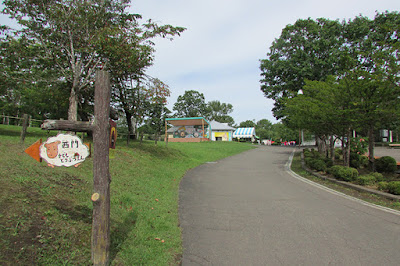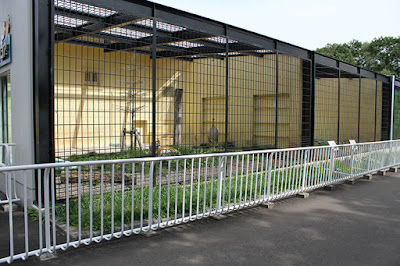After
visiting the Shiretoko Peninsula and Lake Akan, my trip to Hokkaido ended with
a one-night stay in Kushiro, Hokkaido’s fourth largest city with a population
of about 173,000 people. Realizing there
would be about two hours of free time before catching a plane at Tancho Kushiro
Airport, me and a colleague made a last-minute decision to check out Kushiro
Zoo.
Hokkaido Zone
The area that I found most interesting
was the “Hokkaido Zone” which featured animals native to Hokkaido. Looking at the zoo map, this zone appears to
cover about a third of the zoo’s grounds, but much of it is forest, and the
areas actually accessible to visitors comprise only a fraction of the total. Upon entering this zone, visitors could see a
series of small cages containing Ezo Flying Squirrels and Hokkaido Squirrels.
The
squirrel cages were connected by tubular passages and the occupants could move
from structure to structure.
The
Hokkaido Zone also included an actual marsh through which visitors could walk
via a 450 meter boardwalk. (For lack of
time, I did not walk through this area.)
I thought that this marshland area and the adjacent swan pond were good
examples of a zoo incorporating the natural geographical features of its location to showcase native animals.
Swan Pond
Located at the rear edge of
the zoo grounds, the Swan Pond housed a pair of Whooper Swans as well as some
ducks. There were no nets placed above
this pond, so I imagine migratory birds might sometimes use this pond as a rest
stop during their travels.
There
was an observation house that looked like a good place to watch the birds
during the cold winter months.
Visitors could buy food to feed to the swans for 100 yen. I observed two women feeding the “Swan food” to the carp in the pond.
Ezo Brown Bear
The Ezo Brown Bear enclosure
was an old-style concrete structure with a raised mountain in the center
portion. When I first arrived at this
exhibit, the two bears on display were napping.One of the bears awoke when he realized that visitors might offer him bear snacks.
For 100 yen, visitors could buy snack pellets to feed to the bears. This machine was located in the area above the bear enclosure. From this vantage point, visitors could toss bear snacks down into the enclosure.
This
area was located at the same level as the bears. Note the bear snack vending machines
located on the far wall and green-colored pipes located on the wall to the
left.
Visitors
could drop bear snacks into the green pipes.
Bear
waiting for snacks to drop.
Owl Forest
This
large bird-cage area featured owls found in Hokkaido. The cages were laid out such that the birds
could be viewed from four sides.
Eagle
Owl
Snowy
Owl
Monkey Mountain
Located just outside of the
Hokkaido Zone was the “Monkey Mountain” housing the Japanese monkeys. This exhibit featured a concrete
mountain standing in the center of a concrete pit. This type of exhibit is often referred to as
a “Hageyama” or “bald mountain”, and it is a very common style of exhibition in
Japanese zoos.
Visitors
could feed the monkeys for 100 yen.
Ferocious Beast House
Each time I visit a zoo, I
always make a particular effort to observe the enclosures housing the tigers. Tigers are great at attracting visitors, and I
find it interesting to compare the quarters in which they are housed. Kushiro Zoo’s home for the tigers is the “Ferocious
Beast House”, and it is located almost in the center of the zoo.
The
beast house included five separate outside display cells located in a row. (Each had corresponding inside quarters.)
There
were three lions; a male and a female in one cell and a second male in a
separate cell.
There
were also three tigers. A two-year old
male named “Asama” was alone in a cell that appeared to be about 10 meters from
left to right and about 4 meters from front to back.
A
thirteen-year old female named “Choco” (born 2004) was housed in a cell that
appeared to be about 8 meters from left to right and about 4 meters from front
to back.
Many zoo visitors say they are inspired by the story of Cocoa’s survival and struggles, and a number of books and videos telling the story of Cocoa and Taiga were produced. Some of those books and videos are still available for purchase even today.
Other Animals
As
I mentioned at the beginning of this article, the number of species, and the
number of individual animals kept at Kushiro Zoo are relatively low. Still, due to time constraints, I was unable
to see the Wapiti Ezo Deer, Gibbons, Orangutan, Chimpanzee, Reindeer, and
Bison. I do believe I saw just about
everything else. Below are photos of
three other large mammals and their exhibits.
Polar Bear
Giraffe
Amusement park rides
Japanese zoos, especially the
ones located in smaller population markets, tend to include amusement park-type
rides to attract families with young children. Kushiro Zoo was no exception
with equipment including a carousel, a UFO ride, a Ferris wheel, and a Bouncy
house.
Close Encounters with
Animals
Besides the bear-feeding and
monkey-feeding activities discussed earlier, Kushiro Zoo also included a
children’s zoo where visitors were allowed to touch rabbits, guinea pigs,
goats, and sheep. Due to lack of time, I
was unable to take a close look at this area.
Food and Souvenirs
Near the rear of the zoo
grounds, there was an exhibition house where visitors could buy light snacks. (The zoo map also showed two other buildings
marked as “rest areas” where vending machines were said to be located.)The exhibition house included a small section dedicated to the sales of animal related toys and goods, including a few goods such as postcards and pens that were branded with the “Kushiro Zoo” name. Compared to zoos located in larger cities, the selection of goods was quite limited.
Near the Main Entrance, there was an information counter that sold postcards, pens, and DVD’s and books about Cocoa and Taiga.
Getting There
Kushiro
Zoo is located a good distance outside of Kushiro City, and there are no nearby
train lines. The most convenient way to
get there is by car (or perhaps taxi), and it is about an 11-minute drive from
Tancho Kushiro Airport or about a 27-minute drive from JR Kushiro train station
in Kushiro City. The zoo brochure
mentions that access is also possible by bus from JR Kushiro Station, but it
doesn’t mention how much time the ride takes. Admission for adults was 570
yen. Junior high school students and
younger children were admitted free.
(Note:
All photos in this post were taken during a visit made on September 11, 2017. The comments in this post are based on
observations made at that time.
Conditions may have since changed.
Please check it out for yourself!)























































